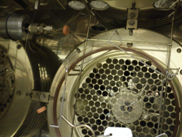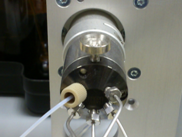Sample requirements
required information about the analyzed sample:
- sample solubility - suitable solvents selection
- sample toxicity - if known
- sample storage conditions - temperature, UV light protection etc.
organic substances:
individual substances are prefered, substance solution accepted (common organic solvents), for ESI and APCI is sample dissolved in organic solvent and further in methanol, acetonitrile or their mixtures with water (at least partial solubility is required)
mixtures of organic substances:
consultation required, suitable solution choice as well as the choice of separation technique
Sample return must be noted in the request form, otherwise is sample wasted. Sample must be picked-up back within two weeks after providing results. After this period is wasted.
Possible sample pre-treatment techniques (consultation required)
- sample concentration under nitrogen stream - solvent evaporation
- solvent extraction
- SPE (Solid Phase Extraction), MEPS (Microextraction by Packed Sorbent)
- SPME (Solid Phase Microextraction)
- filtration - teflon filters 0.22 a 0.45 micrometers
- centrifugation
- derivatization (e.g. silylation)
Sample introduction into the ion source of mass spectrometer
Vacuum ionization technique - EI+ 70 eV , CI
 Sample is injected into the injection port of gas chromatograph. After evaporation, the sample is separated by capillary column and introduced into the source of mass spectrometer by carrier gas (helium). PTV (programmed temperature] injection ports are available, in a combination with a short capillary without phase can be high-boiling analyted introduced.
Sample is injected into the injection port of gas chromatograph. After evaporation, the sample is separated by capillary column and introduced into the source of mass spectrometer by carrier gas (helium). PTV (programmed temperature] injection ports are available, in a combination with a short capillary without phase can be high-boiling analyted introduced.
Atmospheric ionization techniques - ESI, APCI  Sample is injected into the flow of mobile phase through the injection valve with a sample loop. The flow of the mobile phase is introduced into a probe and ion source. In case of HPLC separation the column is used between the valve and probe.
Sample is injected into the flow of mobile phase through the injection valve with a sample loop. The flow of the mobile phase is introduced into a probe and ion source. In case of HPLC separation the column is used between the valve and probe.
